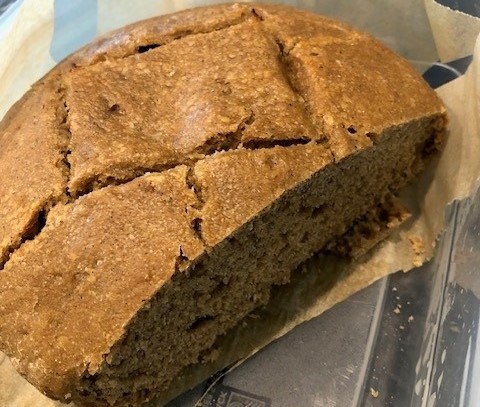
Adventures with Bread
The ark of my life story seems to have bread as a main character.
There were the peanut butter sandwiches I lived on at college; the time I got physically addicted to hamantasch (a doughy pastry filled with poppy seed paste available around the Jewish festival of Purim); the egg salad sandwiches (and assorted pastries) I consumed every day at work in Leeds, the bagels and smoked salmon I looked forward to every Sunday, and the French bread sticks I could consume in a single sitting while pregnant. Is it any wonder I wound up with a gluten intolerance later in life? My older son too. (There’s a bit more to gluten intolerance than the bread itself which you can read about in my book How To Be a Healthy Human; What Your Doctor Doesn’t Know About Health and Longevity).
It’s been years since I’ve been able to enjoy bread or regular baked goods. I’d tell myself it’s this American wheat that’s the problem (hybridized beyond all recognition compared to the wheat of old). I’d look forward to vacations overseas when I could eat “more normally” but alas we went to Israel last summer (July 2023) and after tucking into my first falafel with a wonderfully doughy pita bread I suffered for the next three days.
Even the gluten-free stuff doesn’t really work for me. So full of additives and “gums” it’s mostly an ultra-processed food-like-substance.
But bread has been a staple food since ancient days and is mentioned all over the Bible so what gives?
An excellent TV docuseries from Michael Pollan got my attention recently. One episode is called “Air” and it’s all about the ancient art of bread making. Bread is actually quite magical stuff. All you need is flour and water. Separately they won’t sustain you, at least not for the long term. But combine them and let them naturally ferment with the aid of microbes that are all around us, and you get a nutritional powerhouse that can nourish us indefinitely. Though you need to start from a good quality wheat or other flour, and not the hybridized, refined, glyphosate-heavy excuse for grain most commonly found in grocery stores these days.
Did you know that real bread doesn’t need yeast?
Sourdough is Traditional Bread
You may be mistaken to think that sourdough is just a “flavor” of bread and indeed there are many “fake” sourdough breads available. But sourdough is a method of slow fermenting the dough at room temperature (8 to 10 hours is usually best) which lets the natural microbes in the air and the flour break down the phytic acid (sometimes called an anti-nutrient found in all grains) releasing the nutrients in the flour and enabling the bread to be properly digested and the range of nutrients fully absorbed. The fermenting process also creates enzymes that further help with digestion and breaks down the proteins into useful amino acids. It also lowers the glycemic index making sourdough a better choice for those with blood sugar issues. The only ingredients of real sourdough are flour, water and a little mineral salt. Ingredients such as olives, dates or nuts and seeds can add some interest.
The Ancient Wheat, Einkorn
While making your own bread using a sourdough starter and a long fermenting process is certainly an improvement over commercial offerings, the flour you start from can still be a problem. All wheat today is descended from an ancient wheat called Einkorn. In order to vastly increase yields in the 20th century modern wheat has been hybridized: crossed with grasses which contain different types of gluten and higher levels of gliadins both of which can be detrimental to the gastrointestinal tract of humans. Add the glyphosate, which is liberally used in commercially grown wheat to dry it out before harvesting, and you have a flour that cannot be redeemed through fermenting.
Einkorn is now considered a specialty wheat grain that is grown organically and to ensure no cross breeding with other strains. It has 30 per cent more protein than other wheat and is high in crucial vitamins and minerals. It also has 50 per cent less phytic acid and is absent the most problematic forms of gluten. Jovial is a brand available in most grocery stores that uses Einkorn imported from Italy or there are a few specialty farmers you can buy from directly.
I was very excited when I first heard about Einkorn and that many people with gluten sensitivities do fine with Einkorn products especially traditional sourdough. I bought an Einkorn sourdough starter from Cultured Food for Life which came with Donna Schwenk’s impeccable instructions. I didn’t want to buy any new equipment just in case it didn’t work out. So I bought a small pack of Einkorn wholewheat flour and improvised. My mixing, shaping and baking bowl(s) were one and the same: a large ceramic saucepan that had a lid. I didn’t have a Dutch oven or crockpot. I didn’t have a dough scraper and Einkorn is a little sticky to work with but I muddled through. My fermenting the starter, overnight rising and rest periods were all a little elongated due to other life activities getting in the way. I even forgot to score a square on the top before baking per Donna’s instructions. Then my oven misbehaved and didn’t seem to get to the required 450 degrees for optimum baking. My expectations were therefore very low when I finally pulled it out of the oven. But you know what? That first loaf was AMAZING!
My family thoroughly enjoyed the rich and hearty taste and texture. I had a slice that first day and felt no ill effects. So I had another the next day and the next. On the fifth day, I started feeling uncomfortable chest pains which I recalled from over a decade earlier when I would get them regularly. An ultrasound had revealed pericarditis (inflammation of the sack around the heart) which had led one doctor to run further tests that suggested I might have Lupus, an autoimmune disorder. That was the impetus I had needed to turn my health around (which you can read about more in How to Be a Heathy Human). Fully eliminating gluten was just the start.
 However pericarditis can result from a virus or other causes so I wasn’t ready to give up yet. I waited another three weeks for everything to calm down and then I tried again. My son was begging for some more sourdough so I baked another loaf. I also made some treats for Valentine’s Day with Einkorn and some of the sourdough starter. I went a bit more slowly, having a taste on one day and then nothing the next. No pericarditis ensued but I did have some other aches and pains. The conclusion for me is that even fermented Einkorn is a little inflammatory in my body so it is best avoided. I will probably have the occasional treat once or twice a year if I am otherwise healthy. I will keep a steady supply of Einkorn sourdough for my family though. But will more often stick to nut flours if baked goods are required.
However pericarditis can result from a virus or other causes so I wasn’t ready to give up yet. I waited another three weeks for everything to calm down and then I tried again. My son was begging for some more sourdough so I baked another loaf. I also made some treats for Valentine’s Day with Einkorn and some of the sourdough starter. I went a bit more slowly, having a taste on one day and then nothing the next. No pericarditis ensued but I did have some other aches and pains. The conclusion for me is that even fermented Einkorn is a little inflammatory in my body so it is best avoided. I will probably have the occasional treat once or twice a year if I am otherwise healthy. I will keep a steady supply of Einkorn sourdough for my family though. But will more often stick to nut flours if baked goods are required.
You know your body better than anyone else and only you can decide what is a positive or negative influence on it. But make sure you are honest with yourself and not assuming bread is an innocent bystander in your health issues by default. Knowing where your bread comes from and what it contains is an important factor.



